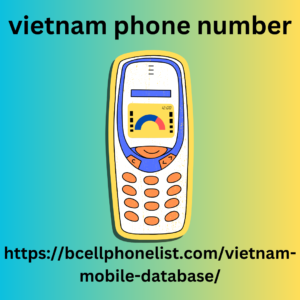Origins, Coverage, and Applications
Introduction
The 646 area code is a crucial part of the telecommunications landscape in New York City, particularly within Manhattan. Understanding its origins, coverage, and applications helps residents and businesses alike navigate the city's complex communication infrastructure. This article delves into the history, geographic reach, and practical uses of the 646 area code, providing a comprehensive overview for anyone seeking to understand its significance.
Origins of the 646 Area Code
Historical Background
The 646 area code was introduced to address the vietnam phone number growing demand for phone numbers in New York City.
Creation and Implementation: The 646 area code was established in July 1999 as an overlay for the 212 and 917 area codes. This transition from fewer area codes to multiple overlays ensured that the increasing number of phone users could be accommodated without disrupting existing services.
Overlays and Numbering Plans: Instead of splitting existing area codes, an overlay was chosen to minimize inconvenience for businesses and residents. This transition allowed existing numbers to retain their area codes while new numbers were assigned the 646 code, facilitating a smoother adjustment period for all users.
Expansion and Demand
The introduction of the 646 area code was a response to the rapidly expanding population and the proliferation of mobile devices.

Population Growth: Manhattan's population growth and its status as a major business hub significantly increased the demand for new phone numbers. The transition from a stable population to a booming one required a flexible and scalable numbering plan.
Technological Advancements: The rise of mobile phones and other telecommunications technologies further drove the need for additional numbers. Transitioning from landline-dominated usage to a more diverse range of devices necessitated a broader allocation of numbers.
Coverage of the 646 Area Code
Geographic Scope
The 646 area code primarily serves the borough of Manhattan.
Manhattan Coverage: The 646 area code covers all of Manhattan, including its iconic neighborhoods and business districts. From the Financial District in the south to Harlem in the north, transitioning from residential areas to commercial hubs, the 646 code is ubiquitous.
Key Neighborhoods: Neighborhoods such as Greenwich Village, SoHo, Midtown, and the Upper East Side are all under the 646 area code. Transitioning from historic districts to modern commercial zones, the area code supports a wide range of communication needs.
Overlay with Other Area Codes
The 646 area code is part of a complex overlay system that includes the 212 and 917 area codes.
Area Code 212: The original area code for Manhattan, 212, was introduced in 1947 and is often associated with prestige and long-standing businesses. Transitioning from exclusive use to shared overlays, 212 numbers are now complemented by 646 and 917 numbers.
Area Code 917: Initially introduced for mobile phones, the 917 area code now also serves landlines and other devices. Transitioning from mobile-specific to multi-purpose, it works alongside 646 to meet the city's diverse communication needs.
Applications and Uses of the 646 Area Code
Business Applications
For businesses, having a 646 area code can enhance their local presence and credibility.
Local Presence: A 646 phone number helps businesses establish a strong local identity, which can be crucial for attracting and retaining customers. Transitioning from a national to a local focus, a 646 number signifies a direct connection to Manhattan.
Customer Service: Many businesses use 646 numbers for customer service lines, ensuring that clients can easily reach them. Transitioning from impersonal to personal, this practice fosters trust and engagement with the local community.
Personal Communication
Residents of Manhattan rely on the 646 area code for various personal communication needs.
Mobile Phones: Many residents use 646 numbers for their mobile phones, reflecting the area's high density of cell phone users. Transitioning from landlines to mobile connectivity, 646 numbers support the fast-paced lifestyle of Manhattan.
Residential Lines: While less common today, some households still use 646 numbers for their home phones. Transitioning from exclusively mobile to including landlines, these numbers ensure continuity and reliability in communication.
Technological Integration
The 646 area code is significant in the context of modern communication technologies.
VoIP Services: Voice over Internet Protocol (VoIP) services often use 646 numbers, offering cost-effective communication solutions. Transitioning from traditional telephony to internet-based services, VoIP with 646 numbers provides flexibility and savings.
Virtual Numbers: Many businesses use virtual phone numbers with a 646 area code to manage calls efficiently. Transitioning from physical to virtual, these numbers enhance operational efficiency and customer outreach.
Conclusion
The 646 area code is a vital component of Manhattan's telecommunications framework, supporting a diverse range of communication needs. Understanding its origins, coverage, and applications highlights its importance in maintaining the connectivity and dynamic environment of New York City. As technology and communication demands continue to evolve, the 646 area code will remain a significant element in the ever-changing landscape of Manhattan.